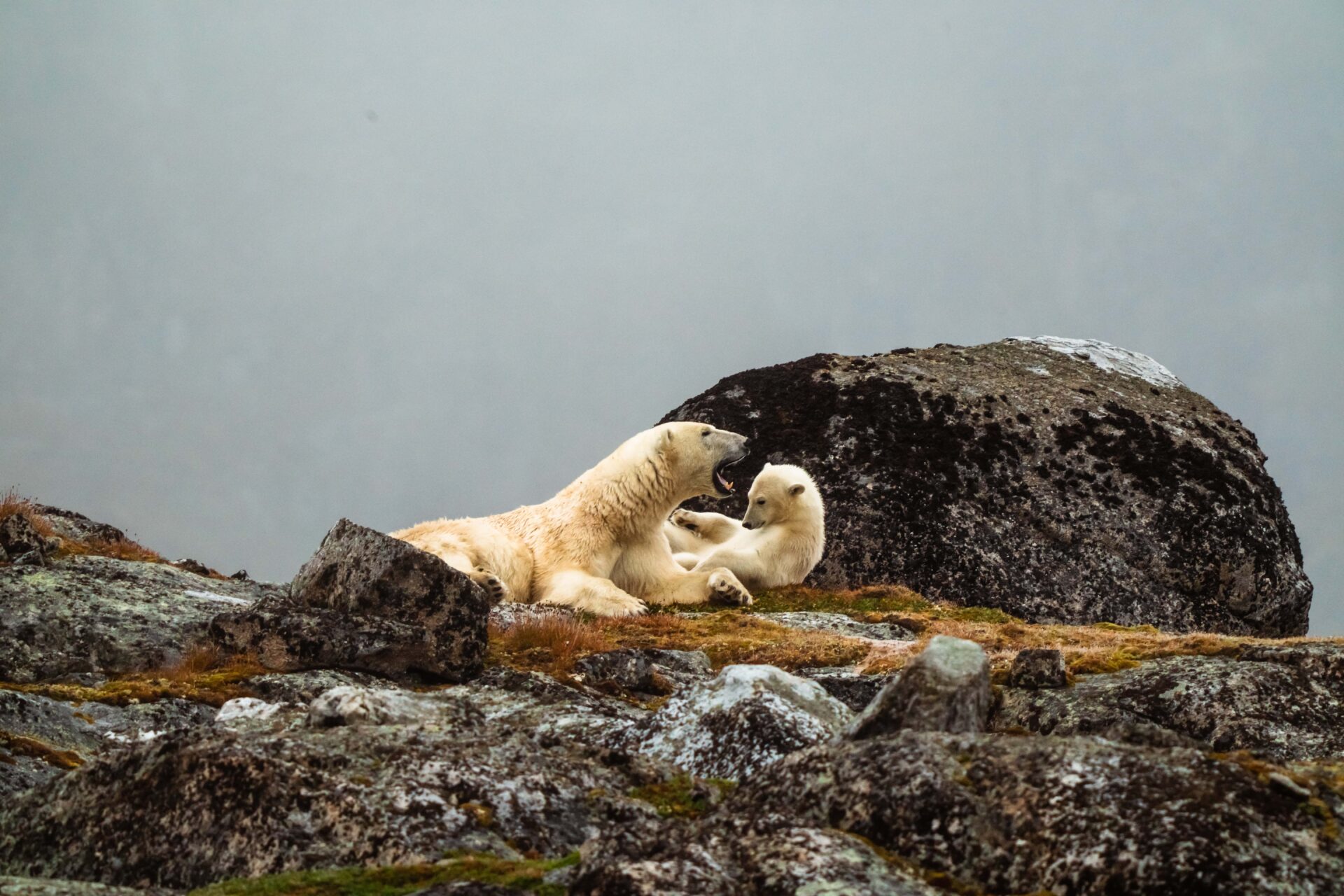The mighty polar bear is one of the trademarks of the Arctic, with its powerful build and shaggy white fur. While never guaranteed, spotting one of these iconic creatures is always a highlight for lucky expeditioners on an Arctic cruise.
However, there is a lot more to these incredible apex predators than meets the eye, which is why we’re diving into the world of polar bears in this ‘Wildlife Fact File’.
Introducing the polar bear
The polar bear is found roaming the coastal waters and the ice sheets of the Arctic, from Alaska and Canada to Greenland and Svalbard. Also known as ursus maritimus, the polar bear is the largest land carnivore on Earth, measuring 1-1.5 metres tall while on all fours – standing on their hind legs they can reach up to 3 metres in height.
Weighing up to a hefty 544 kilograms, the adult male far outweighs its female counterpart, usually ranging from 50 to just under 300 kg. On average, these beasts live for 25-30 years in the wild.
Staving off the cold
When you live in one of the world’s coldest locations, you’d better be prepared for some seriously tough conditions. In winter, polar bears can face bone-chilling temperatures of -50 degrees Celsius and below in the Arctic, with the water close to freezing temperature.
Fortunately, the polar bear is well equipped for its frigid environment, with a heavy insulating coat of fur over a layer of fat. Interestingly enough, even though polar bears appear to be white, their fur is actually transparent, reflecting the light to create the illusion of a snowy white coat. Beneath the fur, a polar bear’s black skin absorbs sunlight to help keep them warm.
Read more: Staying warm on your Arctic cruise

Built to swim
Polar bears are champion swimmers, which draw on their strength to navigate the icy waters of the Arctic. The layer of fat beneath their fur gives them added buoyancy, while their large paws – some 30 centimetres wide – work as paddles, enabling them to swim incredible distances.
Sadly, as the polar ice in the Arctic continues to melt, polar bears’ swimming skills are truly being put to the test, with the longest recorded swim by a bear totaling a marathon 687 kilometres.
What’s for dinner?
A polar bear’s diet is mainly meat based, consisting of fats that enable the polar bear to maintain its body temperature. They favour seals as their main source of food, lying in wait by seal breathing holes until the opportune moment. However, if seals aren’t an option, polar bears will supplement their diet with anything else they can find.
Lonely at the top?
The apex predator of the Arctic, polar bears sit at the top of the region’s food chain with no natural enemies. They also lead a fairly solitary existence, apart from mothers raising their cubs.
With the arrival of spring, it’s time to breed, and the males will seek out female polar bears by following their scent. After mating, the female will dig what’s called a maternity den in the snow, where she will give birth to her cubs in November-December. Usually polar bear mothers will give birth to twins, who grow rapidly during their first years.
Read more: Spotted! The Top 7 Wildlife You’ll See in the Arctic

Looking to the future
Polar bears need sea ice to survive – a resource that is disappearing from the Arctic as the ice continues to melt with warmer global temperatures. However, as stated by Polar Bears International’s Dr. Steven Amstrup, it is still possible to remedy the situation in the Arctic through the significant reduction of greenhouse gas emissions.
Read more: Why do polar bears need sea ice?
Explore the Arctic in search of the mighty polar bear
Browse our featured Arctic expeditions or download our latest Arctic & Global brochure to compare our full range of trips in Greenland, Iceland, Svalbard and the Northwest Passage.
Spitsbergen: Realm of the Ice Bear
Polar Expedition
Focussing on the largest island of the Svalbard Archipelago, we slice through pack ice to find walrus and bearded seals, and sail along spectacular fjords surrounded by jagged mountains that...
8 Days
From USD $11,516.00/pp
Svalbard in Depth
Polar Expedition
Welcome to Aurora Expeditions’ Svalbard in Depth expedition. On this extended exploration of the Svalbard archipelago, there is ample time to enjoy the best of this magical region, a world of...
15 Days
From USD $20,055.75/pp
Jewels of the Arctic
Polar Expedition
Welcome to Aurora’s Jewels of the Arctic expedition.Explore Svalbard, a world of near-endless daylight, where polar bear sightings quicken your pulse, walrus haul out on sea ice and guillemot cries...
13-15 Days
From USD $15,671.25/pp




